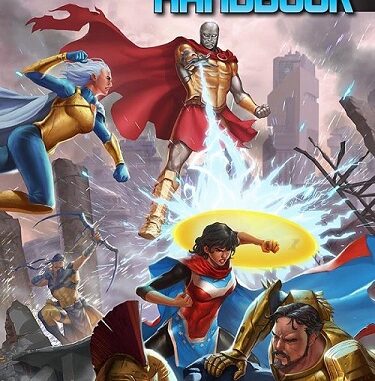
Green Ronin recently released its latest full-size supplement for Mutants & Masterminds 3e, the Superteam Handbook. Even if your group isn’t starting a new M&M campaign right now, the volume is useful, and entertaining.
I’ve always enjoyed the comics history that many M&M books provide. In this book it focuses on, naturally, teams. Not just comic book/graphic novel teams, either. This look back also covers anime, TV, and movies, from Marvel and DC to Sailor Moon and Kyōryū Sentai Zyuranger/Mighty Morphin’ Power Rangers.
Much of the advice in the GMing section is great for running any RPG group, regardless of genre or system. For starters, the writers emphasize communication and kindness. They literally write, “Try not to be an asshole,” but don’t stop there. They go on to talk about exactly how not to be one–and what to do if you realize you were being an asshole, because of course everyone is one at some point, wittingly or not.
Triggers are increasingly being brought up in regards to RPGs (this is a good thing!) and the writers do delve into this matter-of-factly, without being preachy. Included is how character tents (player/PC name cards, sometimes with other info) and X Cards (a way to indicate people need to drop an in-character or out-of-character topic NOW) can help keep games moving along as well as keeping things friendly and non-triggering. The whole communication section is the best I have read on this topic.
Another topic that can help both GMs and players with any genre/system is unsuitable PC concepts. Just about everyone has read the memo about how Lone Wolves–which make great characters in source materials–can really, really screw things up for an RPG group. Superteams, in addition to the usual suspects like Lone Wolves and Traitors, discusses other types of troublesome concepts, including some you may not have realized could be problematic. I had never thought of the Misfits or “players who have to Be the BEST” as more than minor annoyances, for example. The writers spell out the pitfalls, plus offer ways a GM may be able to work with these and other unsuitable ideas.
But you want to know about the M&M specific things, right? Building a team from the ground up is what most of the GM and planning/Session Zero material is about. Various common reasons to team up–common enemies or origins, hero families/clans, Community Service sentences, etc.–get their own subsections with Pros and Cons spelled out. Other topics are “mega-teams” (players may have several PCs they run at different times), codes of conduct, and making teams with varying power levels.
I found the Team Complications interesting. This takes some of the individual hero complications (Addiction, Fame, Rivalry, Secrets, etc.) and shows the GM how to apply them to an entire team. A new Hero Point mechanic is introduced to help. Any time a team complication happens, the Hero Point awarded goes into a pool any player can use, rather than being given to one player by the GM, a bit like the Star Wars RPG Destiny Pool. Alongside this are new “team exclusive” complications–Co-dependence (less effective when members are absent), In-fighting, and Legacy (reviving an older team). To me, it seems easy to adapt the Legacy team complication to individual heroes, given the common trope of legacy hero identities.
Since my game group is in the planning stages of a new M&M campaign, the Team Templates caught everyone’s eyes. These are game packages that every PC pays a few Power Points at character creation to have. In addition to headquarters/vehicle PP contributions (common in many games already) a template may have Skill Ranks, Advantages, and/or certain equipment. The High School Heroes Template we’ll use in that game consists of Equipment 2 (team gear & HQ contributions), Teamwork, commlink, and a school uniform (Protection 2).
There are lots of other goodies. Here are a few of them. There are 2 sets of Team Roles, Tactical (Assualt, Flex, Control, etc.) and Concept (Brain, Outcast, Hotshot, Role Model, etc.), all with suggestions for what to buy. Several new Team Advantages and the Shared Power Flaw and Form are presented. There’s a section on how to better use individual Powers/Skills for the team’s benefit, as well.
The final 100+ pages of the book are 8 sample teams with Power Levels ranging from 5 to 12. Some of them, like the PL 12 United Nations team UNIQUE have been mentioned in previous supplements, but most are new for this book. I thought some of these teams were pretty “out there.” The Outliers (PL10) team reminds me of Legends of Tomorrow, with Weirdness instead of Time Travel. The Shadow Knights (PL 6) have a definite Teenage Mutant Ninja Turtles vibe, except–cute bunnies! There’s also Project Freedom (PL11), which might suit gaming groups who want to make a better Suicide Squad than Warner, DC, and Ayers did. The writers emphasize that these are “soft canon” groups and characters for Earth-Prime. That is, they exist in some form, but may be placeholders for your group’s own teams and team members.
I think Superteam Handbook is a great addition to the M&M line.
Linda Whitson
Latest posts by Linda Whitson (see all)
- Astral Projections – The Ripperdoc Is In - May 8, 2023
